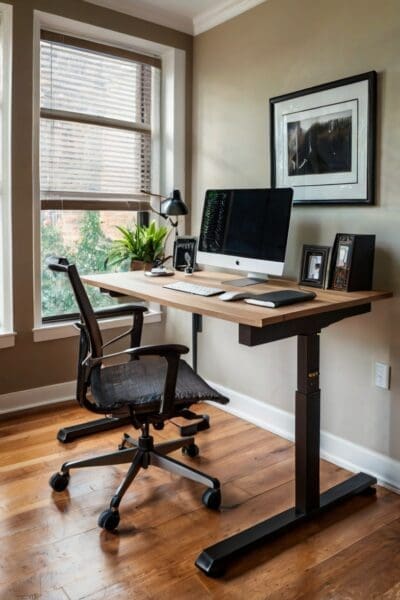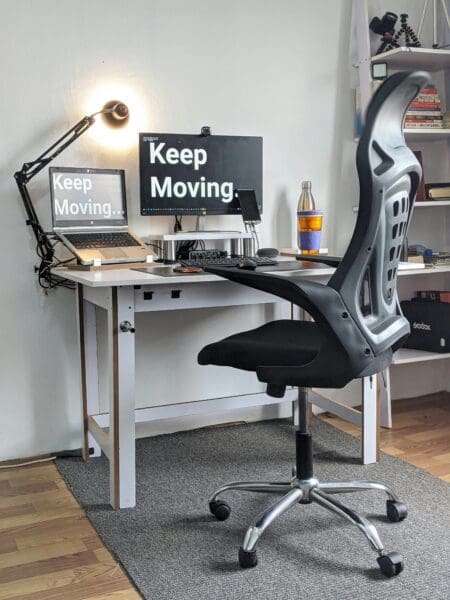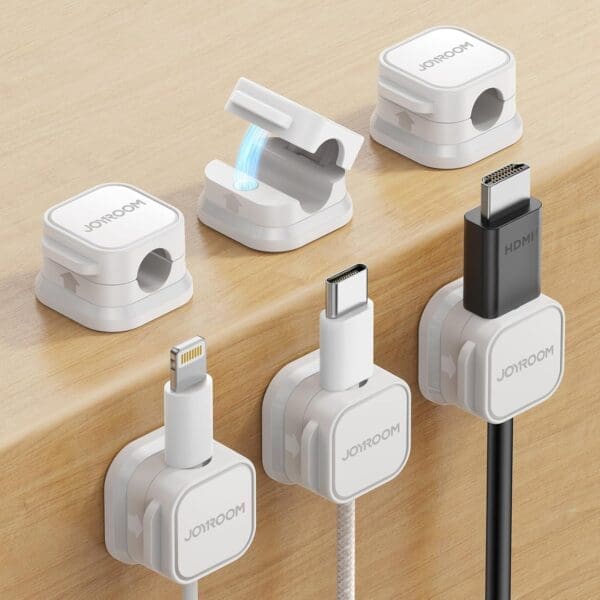Ergonomic Home Office Tips to Eliminate Pain and Boost Comfort
If you are getting a sore back from sitting for hours in your home office, then this article is for you.
When working from home (WFH), creating an ergonomic home office setup is no longer a luxury—it’s a necessity, especially for your back. With the rise of working from home, more people are potentially spending hours in their home offices, making it crucial to design a space that promotes health, productivity, and comfort.
According to a study by the American Chiropractic Association, 80% of Americans will experience back problems at some point in their lives, often attributed to poor ergonomic setups. This comprehensive guide will walk you through the essentials of designing an ergonomic home office that supports your well-being, back and enhances your work performance. Ready to transform your workspace? Start applying these ergonomic tips today and say goodbye to pain for good!

Affiliate links are in this post, more information in disclaimer
Check out these must-have tech gadgets for the home office: 5 Essential Tech Christmas Gifts for Your Home Office
Understanding Ergonomics: Why It Matters
Before diving into the specifics of setting up an ergonomic home office, it’s essential to understand what ergonomics is and why it matters. So, what is Ergonomics? Simply put, it is the science of designing a workspace that fits your needs, minimising discomfort and maximising efficiency. A well-designed ergonomic home office setup can:
- Reduce the risk of musculoskeletal disorders
- Enhance productivity by minimising discomfort
- Improve focus and mental well-being
In contrast, a poorly designed home office workspace can lead to chronic pain (for me, it’s mostly my back), decreased productivity, and even long-term health issues.

More home office decor ideas: The 10 Best Work From Home Office Inspiration Ideas
Essential Components of an Ergonomic Home Office
1. Ergonomic Chair: The Foundation of Comfort
Your chair is the most critical component of your home office setup. An ergonomic chair supports your spine’s natural curve, reduces pressure on your lower back, and promotes good posture. Look for a chair with these features:
- Adjustable height to ensure your feet rest flat on the floor (and knees at 90 degrees);
- Lumbar support to support the natural curve of your lower back;
- Armrests to reduce strain on your shoulders and wrists (these can get in the way, so it will be a personal choice);
- Swivel base for ease of movement to move around your home office.
Comfort is key, especially if you spend long hours working and you don’t want to ruin your back. Choose a chair that offers good lumbar support and height adjustability. Ergonomic chairs can increase productivity by 17%, as reported by the National Center for Biotechnology Information.


2. Home Office Desk: The Right Height and Space
Your home office desk should complement your ergonomic chair and provide enough space for your essentials. Here are some tips for choosing the right desk:
- Height: Your desk should allow your elbows to be at a 90-degree angle when typing.
- Space: Ensure enough space for your computer, documents, and other essentials.
- Adjustability: Consider a height-adjustable desk to switch between sitting and standing positions.
Research by the CDC indicates that standing desks can reduce the risk of weight gain and obesity, offering significant health benefits.
3. Monitor and Screen Placement
Proper monitor placement reduces eye strain and neck pain, where you can use a monitor desk stand riser or monitor arm (attached to the desk). Follow these guidelines for optimal screen positioning:
- Distance: Position your monitor about an arm’s length away from your eyes.
- Height: The top of your screen should be at or slightly below eye level.
- Dual or Ultrawide Monitors: If using dual monitors, position them at an angle to reduce neck rotation.

According to the Vision Council, nearly 60% of adults report symptoms of digital eye strain, highlighting the importance of proper screen placement.
Short on space? 3 Ways to Transform a Bedroom into a Dual-Purpose Home Office
Additional Ergonomic Tools and Accessories
1. Keyboard and Mouse
An ergonomic keyboard and mouse can significantly reduce wrist strain and improve typing comfort. Consider the following:
- Keyboard: Look for a split or contoured keyboard to reduce wrist strain.
- Mouse: Choose an ergonomic mouse that fits comfortably in your hand.
- Positioning: Keep your keyboard and mouse close to avoid overreaching.

2. Footrest
If your feet don’t comfortably reach the floor, a footrest under your WFH desk can provide much-needed support. Benefits of using a footrest include:
- Improved circulation by reducing pressure on the legs
- Enhanced posture by supporting the lower back
3. Cable Management
Messy cables can lead to distractions and even accidents. Effective cable management solutions include:
- Cable trays to keep cords off the floor
- Velcro ties to bundle cables neatly
- Desk grommets for organising wires (get the look below)

Lighting: The Often Overlooked Element
Proper lighting enhances productivity and reduces eye strain. Consider the following lighting tips:
- Natural Light: Position your desk near a window to take advantage of natural light.
- Task Lighting: Use a desk lamp with adjustable brightness for focused tasks.
- Ambient Lighting: Ensure your workspace is evenly lit to reduce glare and shadows.

Personalising Your Ergonomic Home Office
While ergonomics focuses on functionality, adding personal touches can boost your mood and productivity. This will be something you should look into doing with any home office setup. You may want to consider (one or all of these):
- Plants: Incorporate indoor plants to improve air quality and reduce stress.
- Artwork: Hang inspiring artwork to create a motivating environment.
- Colour Schemes: Choose calming colours like blue and green to enhance focus.

Create Your Ideal Ergonomic Home Office Now
When working from home, designing an ergonomic home office is an investment in your health and productivity. By focusing on key components like your chair, desk, and monitor placement, and incorporating additional tools like ergonomic keyboards and effective lighting, you can create a workspace that supports your well-being. Remember, small changes can make a significant difference, reducing the risk of pain and improving your overall work experience. As you set up your home office, prioritise ergonomics to enjoy a more comfortable and productive work environment.
Incorporate these working from home tips, and you’ll be well on your way to creating an ergonomic home office setup that not only looks great but also supports your back, health and productivity for the long haul.
Incorporate these ergonomic ideas to create a cozy home office: 10 Cozy Home Office Ideas to Boost Productivity and Creativity
This post contains Amazon affiliate links, which means I may earn a commission if you make a purchase through these links. Please note that I only recommend products that I believe will add value to my followers. Your support helps keep this content free. Thank you for your understanding and support, more information in Disclaimer!

